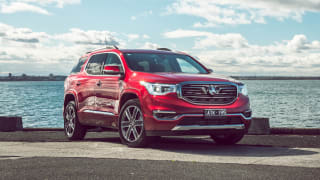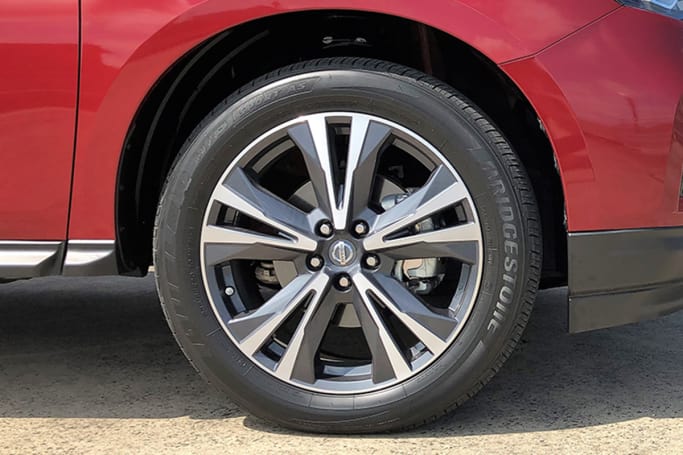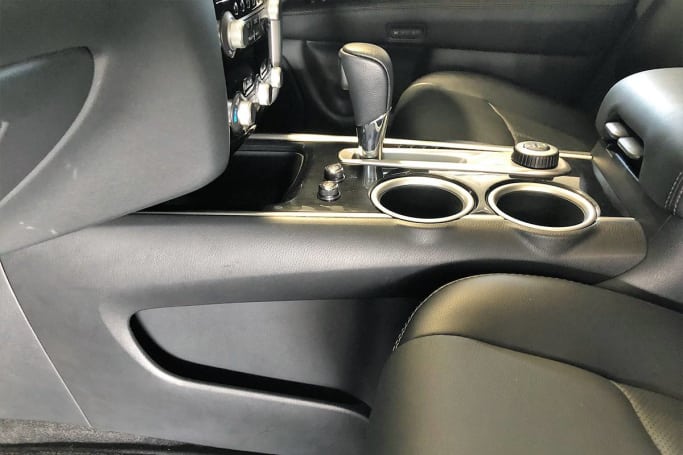
Holden Acadia LTZ-V 2019 review: snapshot
The LTZ-V sits at the top of the Acadia range with the list price for the front-wheel drive version...
Browse over 9,000 car reviews
The Nissan Pathfinder is sort of like the Vegemite of the big-SUV world. It’s been around forever, and even though there are fancier things out there, it’s constantly on people’s shopping lists. And just like a jar of yeast-based goodness, it’s not to everybody’s tastes – but those that do buy them absolutely love them.
So, is the Pathfinder for you?
I tested the top-of-the-range Ti four-wheel-drive version with my family over a week and assessed its practicality, its value, its fuel economy and what it was like to drive.
| Nissan Pathfinder 2019: Ti (4x4) | |
|---|---|
| Safety rating | |
| Engine Type | 3.5L |
| Fuel Type | Premium Unleaded Petrol |
| Fuel Efficiency | 10.1L/100km |
| Seating | 7 seats |
| Price from | $40,370 |
The Pathfinder Ti grade is priciest in the range, and it comes in three forms: a front-wheel-drive petrol, a four-wheel-drive petrol, and a hybrid four-wheel drive. Our test car was the petrol 4WD and it lists for $66,190, making it about $25k more than the entry grade Pathfinder ST 2WD – which is a grade you should check out if you think unloading almost 70 grand on an SUV is a bit much.
That said, you’re getting a lot in return for your money with the Ti.

Coming standard in the cabin is a 13-speaker Bose stereo, a DVD player and a three-zone entertainment system with an eight-inch touchscreen up the front and seat-back screens for the second row, along with two sets of wireless headphones. There’s also leather upholstery, power adjustable front seats with heating and cooling functions, three-zone climate control, an around-view camera, sat nav and a push-button ignition.
A proximity key means you just need the fob in your pocket or bag to unlock or lock the car, and a gesture tailgate lets you just ‘swish’ your foot under the rear bumper to open the boot.
The exterior gets LED headlights and running lights, tinted glass in the second and third row windows, door mirrors that tilt-down when reversing, roof rails and a pair of sun roofs (one over the front seats and one over the second row).
You can also accessorise the heck out of your Pathfinder. In fact, there are three pages of add-ons at the Nissan Australia website - check out the snowboard carrier, for example.

Rivals to the Pathfinder are everywhere. There is the Toyota Kluger, the Holden Acadia, the Mazda CX-9, the Kia Sorento … the list goes on. But the Pathfinder holds its own among this crowd, particularly in practicality, which we’re just about to get to.
What’s missing? Apple CarPlay and Android Auto. These functions mirror your smart phone on the media screen, and they are incredibly useful for keeping your eyes on the road and hands on the wheel.
The Pathfinder’s interior is enormous and the number of storage places and access to power outlets is excellent.
First, legroom in the second row is fantastic. I’m 191cm tall and can sit behind my driving position with about 10cm of space between my knees and the seat back. If I slide that second-row forward to narrow the gap to about two centimetres, I can then sit behind that seat in the third row with about the same amount of room. I can’t do that in a CX-9 or Sorento, but I can in the Acadia.
Headroom is also plentiful in the second row even with the Ti’s sunroof, although I had to dip my head to sit in the third row because of the sunroof housing. I need to do the same in the third row of the top-grade Acadia with its sunroof.
Of the seven-seat SUVs I’ve tested this year (Holden Acadia, Mazda CX-9, Hyundai Santa Fe, Tiguan AllSpace, Volvo XC90, Skoda Kodiaq), the award for easiest rear row to climb into goes to the Pathfinder. Look at my (very bad) photos – the seat base of the second row folds up and the whole thing slides forward, given you plenty of room and great foot placement areas. Also outstanding are the hand grips on the inside of the door frame for children to hold onto as they step up.
Cabin storage is outstanding for the class, with a giant double-layered centre console bin under the armrest that houses two USB ports and a 12-volt outlet, plus there’s a tray in front of the shifter with two 12-volt outlets, as well as slots for papers and books on the side of the console. Second-row riders also have two USB charging points and a media USB port.
Thirsty? The Nissan Pathfinder Ti has 10 cup holders. Two in the front, four in the second row and another four in the third. All doors have big bottle holders, too.
There’s good storage under the boot floor, although the amp for the Bose sound system and the tyre inflation kit do eat into it a bit. If you’re looking for the spare, it’s under the car and it’s a space-saver version.
The cargo capacity with the rear seats folded flat is 1354 litres, and with all seats in place the boot space is 453 litres.
Finally, there’s climate control in the second row, and there are air-vents everywhere you look - including in the third row.
Interesting, you say? The Pathfinder Ti has presence, that’s for sure, with a solid stance and a tough face. It’s handsome, in a rugged off-road way, even though it’s not a serious four-wheel drive like the Nissan Patrol or Navara ute that you’d take across demanding terrain.
The Ti’s interior has the same tough but premium look to it, with plush materials and soft padding everywhere your body touches while sitting in the driver’s seat.
The foot parking brake isn’t nice - it’s an American thing.
The centre console does look a bit dated with its multitude of buttons, but a mate who has a new Pathfinder says that, while it’s a bit old school, he finds it intuitive to use.
The foot parking brake isn’t nice. It’s an American thing, and while it does have a satisfying effect of making you confident that your SUV isn’t going to roll off, I’ve driven tractors that feel less agricultural.
Let’s look at the HMAS Pathfinder’s dimensions because this is a big ship. Measuring more than five metres in length and nearly two metres across, the Pathfinder Ti is long and wide, but not very tall at just over 1.7m. So underground carparks will be fine for height, but where you may be challenged is finding spaces big enough to park in out on the street.
The Pathfinder is available with a 3.5-litre V6 petrol engine making 202kW and 340Nm, or a hybrid petrol-electric powertrain. Ours had the petrol V6, which was introduced in February 2017.
Maximum torque does come in quite high, at 4800revs, which isn’t ideal for fuel economy, but not unusual in big V6 engines such as the one in the Pathfinder and the Holden Acadia.

The transmission is a CVT and it’s one of the best I’ve used, which is saying something because I’m not a big fan of this type of auto as they tend to cause the engine to drone and offer pretty lacklustre acceleration.
This CVT is a revised unit, and it feels so much like a regular automatic that I had to double check the tech sheet to make sure.
Our test car was the 4x4 version of the Ti, and had a braked towing capacity of 2700kg.
According to Nissan, the V6 petrol with four-wheel drive should use 10.1L/100km on a combination of open and urban roads.
I tested that myself, and found that after 190km and driving with the mode selector in Auto (allowing the Pathfinder to choose between front-wheel drive and all-wheel drive on the fly) I was using 11.49L/100km. I measured this at the petrol pump. The trip computer said 10.9L/100km.
That’s not terrible mileage considering I was punishing the Pathfinder everyday sitting in traffic and only clocking up motorway miles on the weekend.
The Pathfinder Ti looks like a bit of a beast, but it’s an easy and comfortable SUV to pilot, despite it being so long and wide. The photos that go with this review are taken at the top of an eight-storey carpark with narrow ramps. The Acadia and CX-9 were trickier to navigate up those ramps than the Pathfinder, mainly because the Nissan offered such good visibility through its giant windows.
Out on the road, the Pathfinder Ti had a comfortable ride, although it was a bit challenged by fast bends. Yup, the Pathfinder isn’t agile, it’s happier to cruise than corner.
Those front seats are big and comfy, the steering is light and that engine has plenty of grunt that it delivers it smoothly and controllably. I found the accelerator pedal to be a bit light and the brake pedal to be too high, but owners will get used to these small quirks.
If you're thinking seriously about off-roading, go for the Nissan Patrol.
The adaptive cruise control worked perfectly for me. I liked the way I could nudge the speed up in 1km/h increments, too, rather than 5km/h like you find on some cars.
A head-up display would be good, though, especially given other car makers are offering them, even on base grades, like with the CX-9.
Do you need all-wheel drive? Nope, but I like the extra traction that it provides and, in wet weather, it offers another layer of safety. If you can afford it, get it. As for off-roading, well you only have a ground clearance of 181mm and while there's hill descent control, there isn't a low-range 4WD gear.
If you're thinking seriously about off-roading, go for the Nissan Patrol - that'll go pretty much anywhere.
Basic Warranty
3 years / 100,000 km warranty
ANCAP Safety Rating

The Pathfinder has the maximum five-star ANCAP rating, but keep in mind that this score was given to it in 2013. The good news is that in 2017 the Pathfinder was updated with some much-needed advanced safety equipment such as AEB, adaptive cruise control and rear cross-traffic alert.
The Ti grade comes with blind-spot warning and Moving Object Detection - which monitors for movement behind the car and will automatic brake the vehicle if it senses something moving close behind it. It’s great for carparks where there could be children or cars moving about.
For child seats, there are three top tethers points and two ISOFIX mounts in the second row, while the third has a top tether point on just the right-side seat.
The second row folds 60:40, but the bigger part is on the left-hand side of the car, which is fine for left-hand-drive countries, where the smaller and easier-to-slide section is on their kerb side, but that’s the traffic side here in Australia.
The Pathfinder is covered by Nissan’s three-year/100,000km warranty. Nissan is now falling behind in a broad industry shift to longer coverage. Ford, Holden, Mazda, Kia, Hyundai, Volkswagen and Skoda now all have five-year warranties and it would be good to see Nissan offer the same. It’s for this reason that the Pathfinder has scored this lower mark for ownership.
Servicing is recommended every 12 months or 10,000km. Capped price servicing is offered, with the first costing $289, the second $302, the third $399, and the fourth $343.
Going by Nissan’s service price guide, after 120,000km you’d have paid $4538 in servicing costs. That’s excellent value.
The Nissan Pathfinder Ti is outstanding in its practicality and value, while offering a comfortable premium feeling experience with materials that feel hard wearing and will put up with the punishment families can throw its way.
| Vehicle | Specs | Price* | |
|---|---|---|---|
| ST (4X2) | 3.5L, PULP, CVT AUTO | $30,800 – 37,070 | 2019 Nissan Pathfinder 2019 ST (4X2) Pricing and Specs |
| ST (4X4) | 3.5L, PULP, CVT AUTO | $30,910 – 37,180 | 2019 Nissan Pathfinder 2019 ST (4X4) Pricing and Specs |
| ST Hybrid (4x2) | 2.5L, Hyb/PULP, CVT AUTO | $30,250 – 36,410 | 2019 Nissan Pathfinder 2019 ST Hybrid (4x2) Pricing and Specs |
| ST-L (4X4) | 3.5L, PULP, CVT AUTO | $36,850 – 43,890 | 2019 Nissan Pathfinder 2019 ST-L (4X4) Pricing and Specs |
| Price and features | 8 |
|---|---|
| Practicality | 9 |
| Design | 7 |
| Under the bonnet | 7 |
| Efficiency | 7 |
| Driving | 7 |
| Safety | 8 |
| Ownership | 7 |
$16,999
Lowest price, based on 51 car listings in the last 6 months